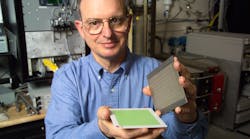Fuel cells depend on a series of chemical reactions to produce clean energy. But the process also has some unhealthy side effects.
Reactions with hydrogen fuel cause irreversible damage to both the catalysts and internal proton exchange membrane. Because the deterioration of these components occurs at the atomic level, it has been difficult for engineers to identify what causes the damage.
Now a research team at the University of Electro-Communications in Tokyo introduced a combination imaging technique that can map the morphology and electronic and bonding states in fuel cells. As a result, it is possible to identify the cause of catalyst degradation.
Along with researchers from the University of Tokushima and the Japan Synchrotron Radiation Research Institute, the team studied fuel cells based on Nafion, a synthetic polymer widely used in proton exchange membranes. In a typical fuel cell, hydrogen is delivered to the anode side of the cell. A chemical reaction in the electrode splits the hydrogen molecules into positively charged ions and electrons. The reaction is carried out by a catalyst in the electrode (usually platinum).
The hydrogen ions are filtered through the proton exchange membrane to the cathode side of the cell while electrons travel through an electrical circuit. The membrane is prone to attack by free radicals produced as a result of the hydrogen-catalyst reaction. The research team found that in Nafion-based fuel cells, these free radicals take the form of platinum nanoparticles, which create holes in the membrane.
In an attempt to identify the origin of these particles, the researchers combined scanning transmission electron microscopy (STEM) and energy dispersive X-ray spectroscopy. By measuring the changes in an electron beam sent through the fuel cell, the research team can take an image of the damaged membrane. When the electron beam interacts with the free radicals in the fuel cell, the researchers can interpret the X-Rays produced as a result and identify the chemical composition of the invasive particles.
The research team used the imaging technology to look at the membrane before and after 300 cycles of gas exchange. They found that two processes were causing the platinum catalyst to deteriorate and further damage the Nafion membrane: the detachment of platinum nanoparticles from the carbon electrode and the formation of platinum ions during the oxidation process.
In the end, they determined that these processes were dependent on the ratio of platinum catalyst to Nafion. By adjusting the ratios, it is possible to reduce the amount of deterioration in the fuel cell and improve its durability and efficiency.
